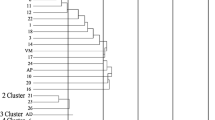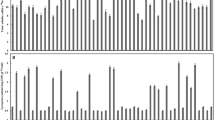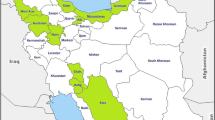Abstract
Garlic (Allium sativum L.) is the second most important Allium crop throughout the world, used raw, cooked, processed or an ingredient of traditional and modern medicine. It is one of the richest sources of total phenolics among the usually consumed vegetables. Indian garlic is indispensable item of globally famous and savoured traditional Indian cuisine. The genotypes grown are mostly short-day type, soft-neck with greater storage ability. Apart from dry bulbs, green garlic leaves are widely consumed in India. In the absence of sexual mode of reproduction, the development of new varieties is limited compared to other Alliums and breeding effort is focused on selection of elite clones from the available genetic resources. The aim of the present study was to (1) study the variations for antioxidants and antioxidant activities in leaf and clove samples of different accessions and (2) study the trait association and diversity in the collection for further selection. Antioxidant compounds were higher in cloves while green leaves were superior for antioxidant activity with variations in few lines. Commercial variety G-323 was found superior for leaf antioxidant activity and clove antioxidant content. Farmers’ variety scored higher for total soluble solids while breeding lines scored better for pungency. Total soluble solids and pungency mostly had negative association with antioxidant compounds and antioxidant activity. The diversity was independent of geographic region and status of selection (varieties, landraces and farmers’ varieties). The quality trait improvement effort should focus on medium TSS and pungent varieties for greater health benefits.






Similar content being viewed by others
References
Abuajah CI, Ogbonna AC, Osuji CM (2015) Functional components and medicinal properties of food: a review. J Food Sci Technol 52:2522–2529
Anthon GE, Barrett DM (2003) Modified method for the determination of pyruvic acid with dinitrophenylhydrazine in the assessment of onion pungency. J Sci Food Agric 83:1210–1213
Apak R, Güçlü K, Özyürek M, Karademir SE (2004) Novel total antioxidant capacity index for dietary polyphenols and vitamins C and E, using their cupric ion reducing capability in the presence of neocuproine: CUPRAC method. J Agric Food Chem 52:7970–7981
Arzanlou M, Bohlooli S (2010) Introducing of green garlic plant as a new source of allicin. Food Chem 120:179–183
Benzie IF, Strain JJ (1996) The ferric reducing ability of plasma (FRAP) as a measure of “antioxidant power”: the FRAP assay. Anal Biochem 239:70–76
Beretta VH, Bannoud F, Insani M, Galmarini CR, Cavagnaro PF (2017) Variability in spectrophotometric pyruvate analyses for predicting onion pungency and nutraceutical value. Food Chem 224:201–206
Block E (2010) Allium botany and cultivation, ancient and mdern. In: Garlic and other alliums: the lore and the science, pp 1–32
Bozin B, Mimica-Dukic N, Samojlik I, Goran A, Igic R (2008) Phenolics as antioxidants in garlic (Allium sativum L., Alliaceae). Food Chem 111:925–929
Cai Y, Luo Q, Sun M, Corke H (2004) Antioxidant activity and phenolic compounds of 112 Chinese medicinal plants associated with anticancer. Life Sci 74:2157–2184
Chen S, Shen X, Cheng S, Li P, Du J, Chang Y, Meng H (2013) Evaluation of garlic cultivars for polyphenolic content and antioxidant properties. PLoS ONE 8:e79730
Corzo-Martínez M, Corzo N, Villamiel M (2007) Biological properties of onion and garlic. Trends Food Sci Technol 18:609–625
Dureja HD, Kaushik KV (2003) Development of nutraceuticals. Ind J Pharmacol 35:363–372
Etoh T, Simon PW (2002a) Diversity, fertility and seed production of garlic. In: Rabinowitch HD, Currah L (eds) Allium crop science: recent advances. CAB Intl, Wallingford
Etoh T, Simon PW (2002b) Diversity, fertility and seed production of garlic. In: Rabinowitch HD, Currah L (eds) Allium crop science: recent advances. CABI Publishing, Wallingford, pp 101–117
FAOSTAT (2016). www.fao.org/faostat/en/#data/QC. Accessed on 14 Nov 2018
Frankel EN, Meyer AS (2000) The problems of using one dimensional methods to evaluate multifunctional food and biological antioxidants. J Sci Food Agric 80:1925–1941
Fratianni F, Riccardi R, Spigno P, Ombra MN, Cozzolino A, Tremonte P, Nazzaro F (2016) Biochemical characterization and antimicrobial and antifungal activity of two endemic varieties of garlic (Allium sativum L.) of the campania region, southern Italy. J Med Food 19:686–691
Gautam S, Platel K, Srinivasan K (2010) Higher bioaccessibility of iron and zinc from food grains in the presence of garlic and onion. J Agric Food Chem 58:8426–8429
Goldman IL, Kopelberg M, Debaene JP, Schwartz BS (1996) Antiplatelet activity in onion (Allium cepa L.) is sulfur dependent. Thromb Haemost 76:450–452
Hendry GAF, Wallace RK (1993) The origin, distribution, and evolutionary significance of fructans. In: Suzuki M, Chatterton NJ (eds) Science and technology of fructans. CRC Press, Boca Raton
Hirata S, Abdelrahman M, Yamauchi N, Shigyo M (2016) Characteristics of chemical components in genetic resources of garlic Allium sativum collected from all over the world. Genetic Resour Crop Evol 63:35–45
Horníčková J, Kubec R, Cejpek K, Velíšek J, Ovesná J, Stavělíková H (2010) Profiles of S-alk (en) ylcysteine sulfoxides in various garlic genotypes. Czech J Food Sci 28:298–308
Kamenetsky R (2007) Garlic: botany and horticulture. Hortic Rev Westport N Y 33:123
Kaushik S, Kumar M, Prakash S, Kumar V, Singh MK, Singh B, Singh K (2016) Study of genetic diversity in garlic (Allium sativum L.) by using morphological characters. Progress Agric 16:204–210
Koruri SS, Banerjee D, Chowdhury R, Bhattacharya P (2014) Studies on prebiotic food additive (inulin) in Indian dietary fibre sources—garlic (Allium sativum), wheat (Triticum spp.), oat (Avena sativa) and dalia (Bulgur). Int J Pharm Sci 6:278–282
Kumar U, Prasad B (2015) Evaluation of garlic (Allium sativum L.) genotypes for plant architecture and yield. J Crop Weed 11:128–131
Lee EJ, Patil BS, Yoo KS (2015) Antioxidants of 15 onions with white, yellow, and red colors and their relationship with pungency, anthocyanin, and quercetin. LWT Food Sci Technol 63:108–114
Lisciani S, Gambelli L, Durazzo A, Marconi S, Camilli E, Rossetti C, Marletta L (2017) Carbohydrates components of some Italian local landraces: garlic (Allium sativum L.). Sustainability 9:1922
Lu X, Ross CF, Powers JR, Aston DE, Rasco BA (2011) Determination of total phenolic content and antioxidant activity of garlic (Allium sativum) and elephant garlic (Allium ampeloprasum) by attenuated total reflectance—Fourier transformed infrared spectroscopy. J Agric Food Chem 59:5215–5221
Mahmutovic O, Mujic E, Toromanovic J, Mustovic F, Muradic S, Huseinovic S, Sofic E (2009) Comparative analysis of total phenols and sulfur content in some plant organs of ramsons and two garlic species. Planta Med 75:43
Moustafa Y, Gadel-Hak SNH, Abdel Naem GF, Abdel-Wahab IA (2011) Studying different quantitative and qualitative traits of some white and colored bulb garlic genotypes grown under a Drip Irrigation system. Aust J Basic Appl Sci 5:1415–1426
Nagella P, Thiruvengadam M, Ahmad A, Yoon JY, Chung IM (2014) Composition of polyphenols and antioxidant activity of garlic bulbs collected from different locations of Korea. Asian J Chem 26:897
NHB (2017) Horticultural statistics at a glance. Horticulture Statistics Division, Department of Agriculture, Cooperation and Farmers Welfare, Ministry of Agriculture and Farmers Welfare, Government of India, p 514
Perrier X, Flori A, Bonnot F (2003) Data analysis methods. In: Hamon P, Seguin M, Perrier X, Glaszmann JC (eds) Genetic diversity of cultivated tropical plants. Enfield Science Publishers, Montpellier, pp 43–76
Petropoulos S, Fernandes Â, Barros L, Ciric A, Sokovic M, Ferreira IC (2018a) Antimicrobial and antioxidant properties of various Greek garlic genotypes. Food Chem 245:7–12
Petropoulos SA, Fernandes Â, Ntatsi G, Petrotos K, Barros L, Ferreira IC (2018b) Nutritional value, chemical characterization and bulb morphology of greek garlic landraces. Molecules 23:319
Piątkowska E, Kopec A, Leszczyńska T (2015) Basic chemical composition, content of micro and macro elements and antioxidant activity of different varieties of garlic’s leaves polish origin. ZYWNOSC Nauka Technol Jakosc 1:181–192
Randle WM, Lancaster JE (2002) Sulphur compounds in alliums in relation to flavour quality. In: Rabinowitch HD, Currah L (eds) Allium crop science: recent advances. CAB Int, Wallingford, pp 329–356
Rivlin RS (2001) Historical perspective on the use of garlic. J Nutr 131:951S–954S
Shimamura T, Sumikura Y, Yamazaki T, Tada A, Kashiwagi T, Ishikawa H, Matsui T, Sugimoto N, Akiyama H, Ukeda H (2014) Applicability of the DPPH assay for evaluating the antioxidant capacity of food additives—Inter-Laboratory Evaluation Study. Anal Sci 30:717–721
Singleton VL, Orthofer R, Lamuela-Raventos RM (1999) Analysis of total phenols and other oxidation substrates and antioxidants by means of Folin-Ciocalteu reagent. Methods Enzymol 299:152–178
Srividya AR, Nagasamy V, Vishnuvarthan VJ (2010) Nutraceutical as medicine: a review. Pharmanest 1:132–145
Stavělíková H (2008) Morphological characteristics of garlic (Allium sativum L.) genetic resources collection -Information. Hort Sci (Prague) 35:130–135
Wall MW, Corgan JN (1992) Relationship between pyruvate analysis and flavor perception for onion pungency determination. HortScience 27:1029–1030
Woodward PW (1996) Garlic and friends: the history, growth and use of edible alliums. Hyland House, Melbourne
Yang CS, Chhabra SK, Hong JY, Smith T (2001) Mechanisms of inhibition of chemical toxicity and carcinogenesis by diallyl sulfide (DAS) and related compounds from garlic. J Nutr 131:41S–45S
Zhishen J, Mengcheng T, Jianming W (1999) The determination of flavonoids contents in mulberry and their scavenging effects on superoxide radicals. Food Chem 64:555–559
Author information
Authors and Affiliations
Corresponding author
Ethics declarations
Conflict of interest
The authors declare that they have no conflict of interest.
Additional information
Publisher's Note
Springer Nature remains neutral with regard to jurisdictional claims in published maps and institutional affiliations.
Rights and permissions
About this article
Cite this article
Bhusal, R., Islam, S., Khar, A. et al. Diversity analysis and trait association study for antioxidants and quality traits in landraces, farmers’ varieties and commercial varieties of Indian short day garlic (Allium sativum L.). Genet Resour Crop Evol 66, 1843–1859 (2019). https://doi.org/10.1007/s10722-019-00811-8
Received:
Accepted:
Published:
Issue Date:
DOI: https://doi.org/10.1007/s10722-019-00811-8




